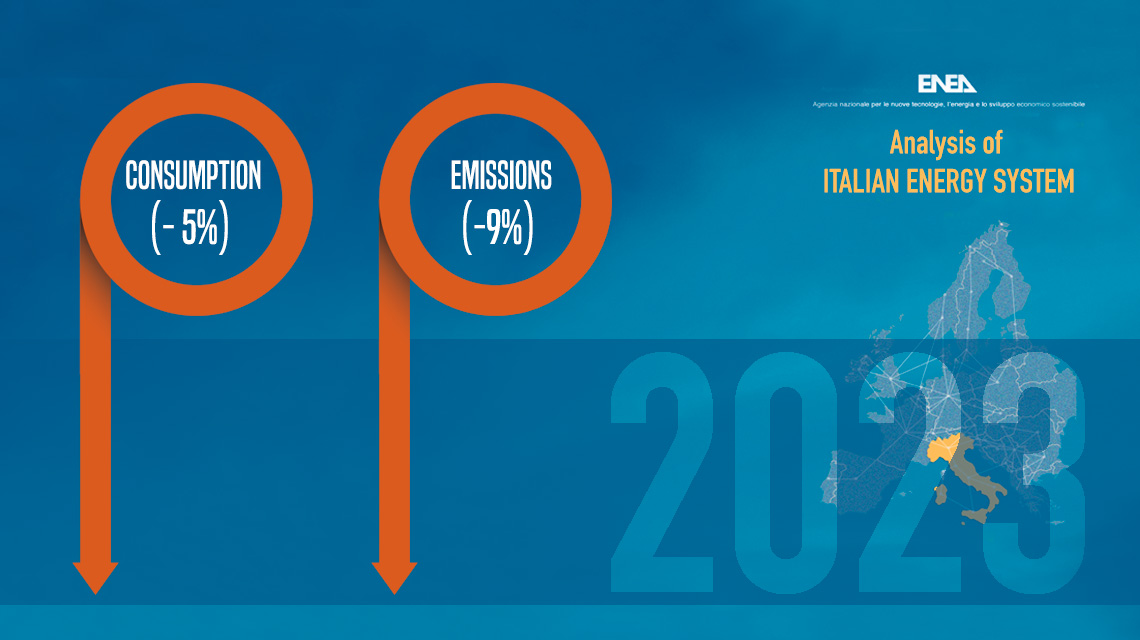Italian National Agency for New Technologies, Energy and Sustainable Economic Development

Energy: ENEA Analysis finds a new drop in both consumption (-5%) and emissions (-9%) in the first half of 2023
Renewables and the ISPRED index up
Despite significantly lower prices, energy consumption continued to decrease in the first half of 2023 (-5% compared to the same period in 2022) following the sharp drop in the fourth quarter of 2022 (-12%). These were the findings of the latest ENEA analysis of the Italian energy system, which also showed a new significant reduction in CO2 emissions (-9%), already down between October and December 2022 after six consecutive quarterly increases.
"The drop in consumption primarily concerns the civil sector (-12%), mainly as a result of the lower use of gas for heating as a consequence of the administrative and efficiency measures adopted, but above all due to the exceptionally mild temperatures in the first months of the year, especially in January", explained Francesco Gracceva, responsible for the ENEA Analysis of the energy system. "Industry also experienced a reduction in consumption (-10%), driven in large part by a drop of up to 20% in production in gas-intensive sectors [1], whose energy consumption is now more than 5% lower than in 2020. Conversely, transport consumption was up (+3%), with almost all of the increase concentrated in Q1 2023 and a gradual return to pre-pandemic levels”.
In terms of energy sources, the reduction in consumption of gas (-16%) and coal (-15%) was offset by a sharp increase in electricity imports (+22%). Electricity renewables are growing (+5%), with renewables’ overall share of final consumption expected to exceed the all-time high of 2020 (20.4%) by the end of 2023. "But the trajectory towards the new target of 40% by 2030 would require much stronger growth", Gracceva noted.
According to ENEA estimates, non-programmable electrical renewables (wind and solar) recorded a new all-time high in the 1-3 pm time slot on 10 April (Easter Monday), covering more than 80% of demand.
The decrease in energy consumption in Italy in Q1 was consistent with the rest of the Eurozone, again due to the mild climate and weak economies. Even in Europe, GDP decreased mainly due to the decline in manufacturing, which was particularly marked in gas-intensive sectors.
Both ETS sectors [2] (power generation and energy-intensive industry) and non-ETS segments (civil, transport, agriculture, waste and small industry) contributed to the reduction of CO2 emissions in Q1 2023. "In the second quarter, on the other hand, the decline was mainly concentrated in the ETS sectors (-19%), primarily due to the lower use of coal in electricity generation (-60%) and the increase in electricity imports (+4%) and electricity renewables (+9%), in addition to the already strong decline in energy-intensive production. By contrast, the drop in emissions in April-June 2023 became marginal in the non-ETS sectors (-2%), confirming the fact that, apart from the decrease in winter gas consumption, no virtuous dynamics seem to be taking place in the civil and transport sectors”, Gracceva added.
After a long series of negative changes and while remaining close to the historical low, the ISPRED [3] energy transition index is improving again (+14% compared to Q1) thanks to the improvement in the decarbonisation component (reduction in the use of coal and energy-intensive production) and to the decrease in electricity and gas prices, which nevertheless still remain well above long-term averages.
"According to preliminary assessments made by ENEA, in the first half of the year the average price of electricity for a company with medium-low consumption was just under €300/MWh (-15% compared to the second half of 2022), while the average price of gas is estimated to have returned to well below €100/MWh in the first half of 2023 (-30% compared to the record in the second half of 2022)”, Gracceva concluded.
The full Analysis and summary of the results will be available shortly at this link: https://www.pubblicazioni.enea.it/le-pubblicazioni-enea/analisi-trimestrale-del-sistema-energetico-italiano.html
